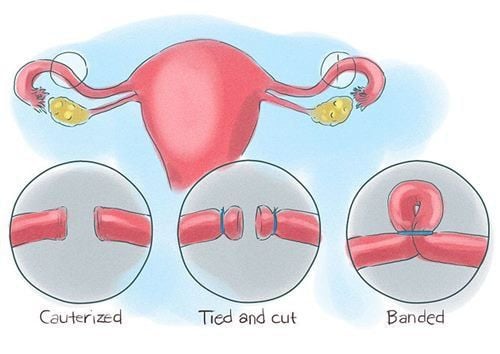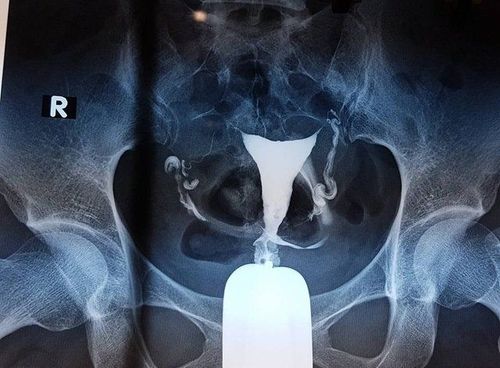This is an automatically translated article.
A tubal ligation procedure, also known as female sterilization, is chosen by women when they have decided on permanent birth control. However, there are still cases where women change their mind and want to get pregnant again after a while. So if I have had a tubal ligation, can I remove it?1. Tubal recanalization surgery
Answering the question "Can tubal ligation be removed?", doctors think that there is still a way to remove the ligated fallopian tubes and this procedure is called tubal recanalization of the ovary. In which, the fallopian tubes will be endoscopically untied or reattached by microsurgery so that the woman can become pregnant and give birth again.The doctor will rely on the following factors before agreeing to appoint a female fallopian tube recanalization surgery:
Age, preferably women under 30 - 40 years old (30% - 80 years old) % success); Previously performed tubal ligation; Overall health; General condition of the ovaries, uterus and fallopian tubes; Length of remaining fallopian tube; Pregnancy history; A surgical history of endometriosis, uterine fibroids, pelvic inflammatory disease (PID), or other gynecological disorders. For women who have had these surgeries, the risk of scarring can affect the success of the tubal ligation procedure. In general, tubal re-canalization will be most suitable for those with a history of:
Removal of only a small part of the fallopian tube; Have used tubal ligation with a ring or forceps; Have a tubal ligation procedure right after your last baby is born.

Bác sĩ sẽ dựa vào Phương pháp thắt ống dẫn trứng đã thực hiện trước đây để quyết định có đồng ý chỉ định ca phẫu thuật tái thông ống dẫn trứng không
2. Preparation before surgery
Both husband and wife must undergo a full physical examination before starting surgery to be sure of their ability to become pregnant after tubal resection. Specific preparation steps are:Blood test and ovarian ultrasound; Measure the length and function of the remaining fallopian tubes (HSG radiograph); Check sperm count and semen quality. All of these testing costs, along with the total cost of hospital fees and anesthetics, make tubal re-canalization surgery (laparoscopic or microsurgery) quite expensive and not on the list of payments for this procedure. Health insurance. Therefore, the patient's family also needs to consider the financial capacity, compare it with the success rate and the level of need before deciding to carry out the surgery.
3. Tubal recanalization procedure
Tubal recanalization is a very complicated procedure because the diameter of the fallopian tubes is very small (only about 1.5 mm) so it needs to be carried out in large hospitals, specialized in laparoscopic / microscopic surgery. gynecological surgery. The patient will be under general anesthesia to be in a deep coma and feel no pain during the surgery.At the beginning of the procedure, the doctor will thread the laparoscope through the patient's navel, into the pelvic area to see the fallopian tubes and decide if it can be re-canalized or not.
If the possibility of tubal recovery is high, the doctor will make a small incision near the patient's pubic hair, roughly called the "bikini cut". Through the microscope that has been attached to the end of the endoscope, all clips or rings that are clamping and constricting the fallopian tubes will be removed. The ends of the fallopian tubes are then reconnected to the uterus with very small stitches.
Normally, a tubal recanalization surgery takes about 2 to 3 hours.
4. Recovery after surgery
Recovery time after surgery depends on the type of surgery performed by the doctor. Tubal recanalization is one of the most complex and difficult abdominal surgeries, taking longer than tubal ligation that the patient has ever performed before.In the past, women needed to stay in the hospital for post-operative observation for 1 to 3 days. But now, more advanced tubal recanalization surgery with microsurgical techniques has made it possible for women not to need to stay in the hospital overnight. After the surgery, the patient will be able to go home the same day, the hospital stay only takes about 2-4 hours from the time the surgery is completed.
The doctor will prescribe pain medication to help the patient manage uncomfortable symptoms after surgery. Most women can return to their normal activities within 2 weeks.

Bác sĩ sẽ kê toa thuốc giảm đau để giúp bệnh nhân kiểm soát các triệu chứng khó chịu hậu phẫu
5. Complications and risks
All surgeries carry risks and complications. For tubal restoration microsurgery, although very rare, patients may experience:Bleeding, infection and damage to nearby organs; Reaction to anesthetic; Risk of ectopic pregnancy life-threatening condition; Sometimes scar tissue forms and blocks the fallopian tubes. In addition, women who want to get pregnant again after a tubal ligation procedure can opt for in vitro fertilization (IVF) as an alternative to tubal resection. In addition, in vitro fertilization (IVF) is also a suggestion in cases where women still cannot get pregnant after having surgery to restore fallopian tubes.
In short, around the issue of "Can a tubal ligation be removed?", doctors confirm that it is possible to connect the fallopian tubes for women who have been sterilized but want to have children again. Tubal recanalization is a complex microsurgical technique, the success rate depends on the time and type of tubal ligation that the patient has performed in the past. On the other hand, women's ability to continue to reproduce depends on age, so hospitals usually only accept tubal rehabilitation for patients under 40 years old and do not have fluid retention damage in this organ.
Please dial HOTLINE for more information or register for an appointment HERE. Download MyVinmec app to make appointments faster and to manage your bookings easily.
Reference source: Webmd.com












